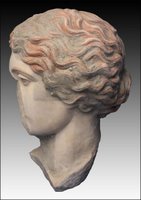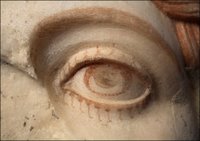Important troballa

Imatge: Cap d'amazona trobat a Herculà.
No sé si sabreu que les escultures gregues i romanes, fins i tot les de marbre, no eren tal com les veiem nosaltres ara, sinó que eren policromes.
De fet, fa poc més d'un any els Museus Vaticans van presentar-hi una mostra de reconstruccions d'escultures grecoromanes conjuntament amb la Antikensammlungen und Glyptothek de Múnic i la Ny Carlsberg Glyptotek de Copenhaguen: I colori del bianco - Mille anni di colore nella scultura antica, i van editar-ne un catàleg amb diversos estudis.
Ara, però, a la ciutat d' Herculà, sepultada en l'erupció del 79d.C. al mateix temps que Pompeia, s'ha fet una troballa espectacular: un bust de marbre d'una amazona que encara conserva clarament restes dels seus colors originals.
A continuació podeu llegir-ne més coses:
Rare Painted Roman Sculpture Found(Segueix)
By Rossella Lorenzi, Discovery News
March 31, 2006— The marble head of an Amazon warrior woman has emerged from Vesuvius' volcanic rock with her make up still on, archaeologists announced this week.
Buried by the eruption that nearly 2,000 years ago covered Pompeii and the nearby towns of Herculaneum and Stabiae with nine to 20 feet of hot ash and pumice, the painted marble bust was found in a collapsed escarpment near Herculaneum's Basilica.
The newly found Amazon head belonged to a group of sculptures which adorned the Basilica, or the law courts.

Imatge: Detall de l'ull de l'amazona.
Almost entirely destroyed by an earthquake 17 years before the eruption, the Basilica was rebuilt by proconsul Marcus Nonius Balbus. Statues of his family decorated the building.
Unearthed in the 18th century, when the entire town of Herculaneum was discovered by chance during the construction of a well, the statues were washed in the subsequent restoration and lost their coloring.
They are now on display at the Archaeological Museum in Naples.
With her colored hair and make up, the Amazon lady is one of the few remaining examples of a Roman painted statue.
The nose and mouth are missing, but the hair, pupils and eyelashes look just like they did when Herculaneum was buried by the eruption, Jane Thompson, project manager of the Herculaneum Conservation Project, told Discovery News.
The Herculaneum Conservation Project is a Packard Humanities Institute-sponsored scheme that aims to ensure the survival and enhancement of the site.
"It has incredibly well -preserved orange-red coloring on the hair and eyes," Thompson said.
The Basilica around which Thompson's team carried out consolidating work was linked to the cult of Hercules.
"Probably the statue was meant to represent Hercules' ninth labor to retrieve the belt of the Amazon queen Hippolyte," Thompson said.
According to Pietro Giovanni Guzzo, superintendent of archaeology at Pompeii, this is an important discovery.
"It is very unusual to find such a statue. It has been 10 years since two polychrome statues had been found in Herculaneum's Villa of the Papyri," Guzzo said.
The conditions of Herculaneum are worrying archaeologists. In several areas of the town, roofs are collapsing, frescoes, marble floors and mosaics are damaged by rain, ground water and pigeon droppings.
Thompson's team has brought in falcons to chase away pigeons, restored crumbling frescoes and buildings, and managed to reopen to the public areas closed to visitors for years.
Més info:
The Times
[Per mitjà de David Meadows]




